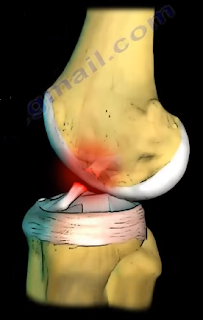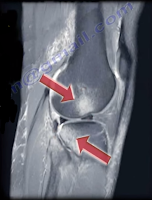The anterior cruciate ligament is located at the front of
the knee. Rupture of the anterior cruciate ligament (ACL) is a condition
commonly seen in sports, usually due to a non-contact pivoting injury. The
Pivot Shift test is a specific test for an ACL deficient knee (ACL injury).
A pivot shift is pathognomonic for an ACL tear and is best demonstrated in a
chronic setting. The Lachman’s test is the most sensitive examination test for
an ACL injury.
The ACL keeps the tibia from sliding out in front of the femur
and provides rotational stability to the knee. Rupture of the ACL causes
anterolateral rotatory instability. The tibia moves anterolaterally in
extension; however, when you flex the knee the IT band becomes a flexor of the
knee and pulls back, reducing the tibia. The Pivot Shift Test goes
from extension (tibia subluxed) to flexion, with the tibia reduced by the
iliotibial band.
Both the Lachman’s test and the Pivot Shift test are
associated with 20-30 degrees of knee flexion. The Lachman’s test starts at
20-30 degrees of flexion, but with the Pivot Shift test, you will feel the clunk at
20-30 degrees of flexion. Remember: 20-30 degrees of flexion is important for
examination of the ACL. The femur is stabilized with one hand and the other
hand pulls the tibia anteriorly and posteriorly against the femur. The tibia
can be pulled forward more than normal (anterior translation). The examiner
will have a sense of increased movement and lack of a solid end point.
When performing the Pivot Shift test, the patient should be
totally relaxed and lying supine. The knee is in the
subluxed position when in full extension. The pivot shift starts
with extension of the knee and you can feel a “clunk” at 20-30 degrees of
flexion. The physician will hold the knee in full extension, then add valgus force, and internal
rotation of the tibia to increase the rotational instability of the knee. Then
the physician will take the knee into flexion. A palpable clunk is very specific of an
ACL tear. The iliotibial band will reduce the tibia and create the clunk on the
outside of the knee. The physician should always compare the results with the
other side.
 The ACL prevents anterior translation of the tibia. It is a
secondary restraint to tibial rotation and varus and valgus. The ACL consists
of two bundles:
The ACL prevents anterior translation of the tibia. It is a
secondary restraint to tibial rotation and varus and valgus. The ACL consists
of two bundles:- The Posterolateral Bundle
- Anteromedial Bundle
The Lachman’s test is the most sensitive test, especially in
acute settings. The examiner will find no end point with anterior translation
of the knee and the physical examination can be difficult or limited due to
pain. With the Pivot Shift test, the patient must be completely relaxed. The
test is helpful in chronic situations, especially if the patient complains of
the knee giving way.
During the Pivot Shift, the knee subluxes in extension and reduces
at 20-30 degrees of flexion. The Pivot Shift correlates closely with patient
satisfaction of their reconstructed knee. It is also a measure of functional
instability following ACL reconstruction. Verticle femoral tunnel placement
will cause rotational instability seen as a positive pivot shift, and the
malposition of the bone tunnel will be seen in an AP view x-ray of the knee. The
9 or 10 o’clock position is better than the 12 o’clock. A vertical position is
bad.
The patient with an ACL injury usually has a non-contact
pivoting injury even with:
- Awkward landing
- Feeling a “Pop” sensation
- Immediate swelling
- Aspiration usually shows blood in the knee (75% chance of ACL tear with hemorrhage in the knee)
- Positive Lachman’s Test (may be hard to examine due to pain)
An MRI is going to be the best imaging technique. An MRI of
the knee joint will show bone lesions or bruising in the typical location
associated with tears of the ACL. These injuries are typically located at the
middle of the femoral condyle and posterior part of the tibia laterally. It is
also possible to find a triple injury within the MRI (O’Donoghue’s Unhappy
Triad).
O’Donoghue’s Unhappy Triad consists of:
- Tear of the Lateral Meniscus
- Anterior Cruciate Ligament Injury (ACL tear)
- Medial Collateral Ligament Injury
In chronic ACL tears, the posterior horn of the medial
meniscus is the most commonly injured structure. In acute ACL tears, send the
patient for therapy for range of motion, brace the patient, and allow the MCL
to heal and reconstruct the ACL later if needed. It is important to stress
hamstring therapy in ACL tears. The patient will probably complain of
instability immediately or later on.







